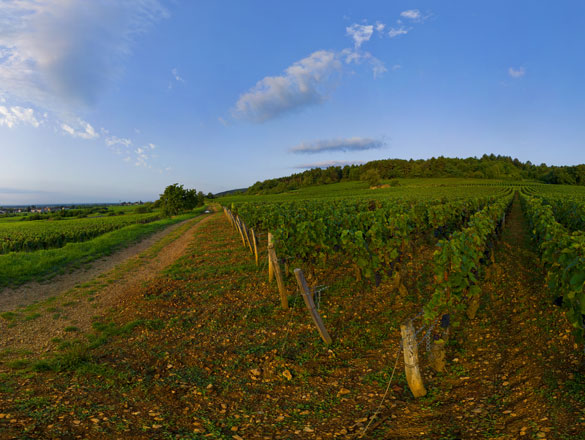

The vineyards of Bourgogne produce some great wines with a historical and international reputation. However, the region is not simply limited to its iconic appellations. In addition to its Village Premier Cru and Grand Cru AOCs, it also produces a range of wonderful Régionale and Village appellations to explore.
You will also find a full list of the Bourgogne’s Climats and lieux-dits on this page.
Check out the complete list of the 84 Bourgogne appellations.
However, your exploration has only just begun. Bourgogne wines have never before offered such high quality. Besides our range of internationally celebrated wines, try some of our lesser-known appellations where there are lots of surprises in store.
And for a fun way to find out more about the wines on offer, try out our “Which Bourgogne wine is right for me?” quiz, or check out Bourgogne Maps to take an interactive tour of the region.
Village appellation
VIGNOBLE DE LA CÔTE DE NUITS
19 mai 1987
Reds and rosés - Pinot Noir.
Whites - Chardonnay and Pinot Blanc.
Area under production*:
1 hectare (ha) = 10,000 m2 = 24 ouvrées.
Reds: 214.14 ha
Whites: 50.55 ha
Rosés: 16.18 ha*
Average annual yield**:
1 hectolitre (hl) = 100 litres = 133 bottles.
Reds: 7,596 hl
Whites: 1,833 hl
Rosés: 699 hl
*In 2022 **5-year average, 2017-2021
Appellation Village of the Côte de Nuits region (Côte-d’Or).
Producing communes: Marsannay-la-Côte, Couchey, Chenôve.
The name of the appellation may be followed by the name of the Climat looking forward to classifing the Climats in Premier Cru.

Marsannay is the only appellation Village which produces wines from all three colours. Their typicity is that of the Côte de Nuits, and their style resemble that of their neighbouring appellations Fixin and Gevrey-Chambertin.
The Marsannay reds have intense coloration and a bouquet which smoothly blends red fruits (morello cherry, strawberry) and black (blackcurrant, blueberry). In the mouth, the attack is powerful and generous shading into a long and meaty finish.
The whites run through the entire gamut of citrus aromas and white flowers (hawthorn, acacia). The mouth is frequently full and rounded, introducing a fine and persistent minerality. Both reds and whites are delicious while still young but, given time, will more fully reflect the typicity of their terroir.
As for the Marsannay rosés, made by direct pressing, their tender fruitiness recalls vine-grown peaches and gooseberry and in the mouth they are characteristically full, fresh, and enticing.

The Marsannay reds are natural partners for red meats: beef blade or rib steak, or flank steak with shallots, ostrich steak… Feel free to marry them with freshwater fish (pike, pikeperch, even stuffed carp) or chop suey and vegetable stirfries, fine cured meats, game fowl, cheeses made from cow’s milk...
An old vintage will add a touch of perfection to full-flavoured cheeses such as Epoisses or Munster.
Serving temperature: 15 to 17 °C.
The Marsannay rosés can be served throughout the meal, with summer barbecues and mixed salads, fine cured meats, white meats, crab and red mullet… And not forgetting oriental, mediterranean, and other highly-spiced foods. Try one that has aged for a few years with a dessert – heavenly!
Serving temperature: 12°C.
With white Marsannay, white meat: poultry (fattened chicken, chicken with a mustard sauce such as à la Gaston Gérard…), veal, pork (a filet mignon with mustard sauce). Also try one with a risotto or with asian cuisine - sushi for example - which brings out the full fragrance of the Chardonnay. After some years’ keeping, they can accompany classic or goat cheeses.
Serving temperature: 12 to 13°C.

Regarded as the “Golden Gate to the Côte de Nuits”, the appellation MARSANNAY covers the communes of Chenôve, Marsannay-la-Côte and Couchey. There is evidence of vineyards here, as is the case of the rest of the Côte, as early as the 7th century and the prestige of this vine-growing region is long-established.
The Abbey of Bèze, the Bishop of Autun, the Dukes of Bourgogne, and many others have owned vines here and the wines found their way to the tables of Louis XIV and Louis XVl. As late as the 19th century, some Climats enjoyed a classification equivalent to today’s Grands Crus.

The vines extend from North to South along the best parts of the hill-slope and the ground at its foot at heights of 255 to 390 metres above sea-level. Exposures range from due east to south. The soils, derived from mid-Jurassic strata, are very diverse in their composition.
